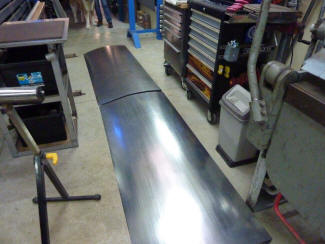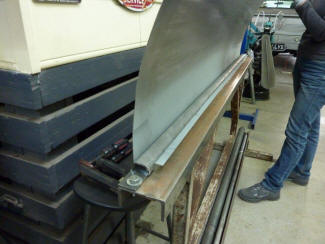

So I waited until my wife could help me pass the sheet through the wheel. I was also able to use light pressure to fix the first panel some more, but you can still see how much smoother the far most panel is when done with the 2 of us from the start. I did manage to match the crown of both halves first go though! So this is the form I made by cutting a pipe in half and then tack welding it to some flat bar. I then placed the form inside the folded part of the panel and bolted it down to the stand.
Then I just pulled it over by myself, (video to come), and finished the roll using the lead beating bat. Here you can see the finished rounded edge. Now just have to repeat it for the other half of the cover which will be welded to this later.
To create a bead you need extra material if the bead does not run right to the ends. Normally I do this by passing it through the English Wheel with a high crown anvil. But as I was on my own again, I did the stretching by belting the 'T' dolly along the marked area where the bead will be, directly over my steel bench. Then hit it some more with the chaser to make it a bit more even. You could just directly hammer the whole thing too, but do not go outside the bead area. I have never been able to pre-stretch too much for large beads like this. I had to do some extra machining to my 19mm-3/4" bead dies as they were not nesting properly. They need to be able to fit inside each other with only a material thickness left. On the right of the roller going into the dies is the rough pre-stretched area, and on the left the first pass coming out.
Can see how it is starting to smooth out already. I also ran guide lines each side of the outside of the top die to make it easier to follow accurately. Increasing the pressure for the return pass, you can now see on the right how much better the bead is getting. I did around 7 passes in all to get it to full height.
Rounded the end of the bead using a piece of notched pipe. There is still some pull down around the bead area showing it still didn't have enough pre-stretch, so will have to address that later. Last bead being done on this half of the tonneau cover.
One half done, another half still to go. With both sides now done it was time to tack them together. See how uneven the metal is before I have stretched the tacks after welding. I will get it even before I start to TIG weld this all together. Some puckering at the end of the beads show more pre-stretch was needed. I'm not too concerned at this stage as I will be cutting part of the unfolded ends away to add the same rounded profile as the sides. Just couldn't be done all at once as tried to fold and roll on a test piece, but it was not possible.
Getting the centre weld looking like this took twice as long as normal! Probably 12 hours all up from cutting, tacking together, welding, planishing, grinding, and sanding this 6 foot join. I couldn't reach into the centre with the dolly in one hand while seeing what my hammer was doing on the topside at the same time. I ended up balancing the dolly on a trestle underneath while hammering from the top. Moved it forward a little and repeated. Problem was I couldn't really 'feel' how the metal was responding and often overstretched the area. Then had to shrink it and then fine tune once again. Live and learn. Another thing I made the mistake of doing on the first rolled side was not adding packers under the bolts for the half round die the same thickness as the sheet. What happened was that the die bent upwards when tightened and the sheet followed the arc when I pulled it over to make the rounded edge. I used a shrinking disc across the top which got it down to this gap, but that is still too much.
Next thing I tried was clamping it down and then stretching along the bottom edge to help pull it down some more. That worked but it pulled it sideways instead!
So to fix the sideways inwards pull, I carefully heated the edge of the fold to move it back straight again. I used a tig torch for this as it gives great localised heat. As soon as the arc was established, I quickly moved the torch along in little circles stopping a weld pool from forming. Got is straight but now the other bend is back even worse!!!
After the first bend I found clamping down the centre until the sheet started to touch the clamp head at about 45 degrees, I could then pull the rest of the sheet over without it lifting. One of the end sections shown being done here. Also completing the bend by pelting down on a fence post with a 4lb mallet kept it straight and made the bend tighter.
[Index]